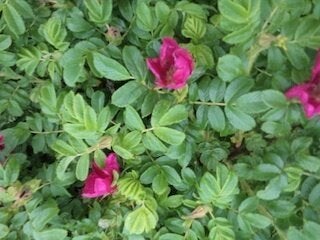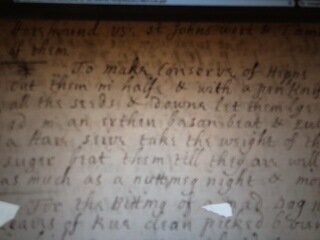
Hedges on an Outer Hebridean Isle are few and far between but wide clumps of Rosa rugosa, bank ditches and serve as sprawling garden boundaries. When the wind blows in the right direction its perfume is intoxicating.For the forager Rosa rugosa petals are easier to gather than those of the dog or downy rose because the petals are larger and the thorns, easier to avoid. Rosa rugosa is considered by many to be a weed, but to my mind it is one of the prettiest flowers to grace the countryside; never more so than when the hectic pink rose is mingled with a virgin white rose.The Briar or Dog Rose scrambles in and out of country hedgerows, where indiscriminate use of air and tractor sprayed pesticides hasn't caused hedges to die and farmers have allowed hedgerows to flourish. Hedges offer shelter and food to wildlife too.Gathering unsprayed petals is a laborious task and a breath of wind will quickly empty the forager's basket, so gather the petals in sunshine on a still day.
In the Kitchen:
Steep the petals in gin or vodka for a scented pink spirit.
Infuse the petals in water and use the scented pink water to make sugar syrup for cordial. There is an orange and rose recipe in The Forager's Kitchen
The more skilful might like to distil the petals to make rose water but others could use petals to replace rose water to add both scent and texture to Turkish Delight.
Freeze the petals and when you open the bag on a cold winter's day, a waterfall of scented summer memories is released. I have a theory (not evidence based) that the pink dye is stronger, when I cook with frozen petals. Rose petal jam will also capture those happy summer moments and unsprayed garden petals work as well.

A cornucopia of rose recipes may be found in Flowers As Food by Florence White including a 1671 recipe for lozenges, and a rose vinegar which includes the use of the leaves too.
When late summer turns to autumn, it's time to make rose hip syrup. The Ministry of Food made this famous during and after the Second World War, as a rich source of Vitamin C. The recipe is here In Scotland the powder inside the hips is called itchy coos. Those seeking instruction for Itching podwer will find it here
Historically petals and hips were used in recipes as in this 1680 recipe for Hipp preserve

Image with thanks to The Wellcome Library, London
Rose hip syrup may also be used in puddings and autumn jellies and then there is wine...the culinary possibilities are endless.